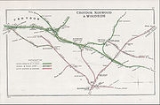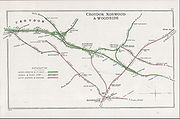
Addiscombe railway station
Encyclopedia

Addiscombe
Addiscombe is a district of south London, England, located in the London Borough of Croydon. It is situated south of Charing Cross.It is situated just to the northeast of central Croydon, and is home to a high proportion of people who commute to Central London, owing to its proximity to the busy...
(towards east Croydon
Croydon
Croydon is a town in South London, England, located within the London Borough of Croydon to which it gives its name. It is situated south of Charing Cross...
). It was on Lower Addiscombe Road between Hastings Road and Grant Road. The East India Way housing development now stands on the site.
Originally it was built with three platforms featuring extensive canopies, as well as a fairly large station building and concourse. However, the station was slowly run down. In 1956 platform 3 was closed and removed, the goods yard closed in 1968. Through trains to London were withdrawn and the service reduced to a shuttle service to and from Elmers End. In 1993 the carriage depot was closed and around the same time the station became unstaffed. When the signal box was burnt down in 1996 the line was reduced to single track and only platform 2 was used. The last train (an enthusiasts' railtour) was on the evening of Saturday 31st May 1997 which also visited the West Croydon- Wimbledon line which also closed on the same day.
After closure in 1997 the station remained derelict for several years until demolition in 2001 .
History
Opened by the Mid-Kent RailwayMid-Kent Railway
The Mid-Kent Line is the name used by the successors to railways built by the Mid Kent Railway and South Eastern Railway between 1857 and 1882. The railway was originally planned the border of the counties of Kent and Surrey, and on to Westerham and Sevenoaks but a combination of factors caused it...
it was part of the South Eastern Railway
South Eastern Railway (UK)
The South Eastern Railway was a railway company in south-eastern England from 1836 until 1922. The company was formed to construct a route from London to Dover. Branch lines were later opened to Tunbridge Wells, Hastings, Canterbury and other places in Kent...
which became part of the Southern Railway
Southern Railway (Great Britain)
The Southern Railway was a British railway company established in the 1923 Grouping. It linked London with the Channel ports, South West England, South coast resorts and Kent...
during the Grouping
Railways Act 1921
The Railways Act 1921, also known as the Grouping Act, was an enactment by the British government of David Lloyd George intended to stem the losses being made by many of the country's 120 railway companies, move the railways away from internal competition, and to retain some of the benefits which...
of 1923. The line then passed on to the Southern Region of British Railways
Southern Region of British Railways
The Southern Region was a region of British Railways from 1948. The region ceased to be an operating unit in its own right in the 1980s and was wound up at the end of 1992. The region covered south London, southern England and the south coast, including the busy commuter belt areas of Kent, Sussex...
on nationalisation in 1948. When Sectorisation
British Rail brand names
British Rail was the brand image of the nationalised railway owner and operator in Great Britain, the British Railways Board, used from 1965 until its breakup and sell-off from 1993 onwards....
was introduced, the station was served by Network SouthEast
Network SouthEast
Network SouthEast was one of three passenger sectors of British Rail created in 1982. NSE principally operated commuter trains in the London area and inter-urban services in densely populated South East England, although the network reached as far west as Exeter...
until the Privatisation of British Rail
Privatisation of British Rail
The privatisation of British Rail was set in motion when the Conservative government enacted, on 19 January 1993, the British Coal and British Rail Act 1993 . This enabled the relevant Secretary of State to issue directions to the relevant Board...
ways. During its last years it received the railcode of "NWW" and was in travelcard zone 5.
The station also underwent several changes of name:
- 1 April 1864 Station opens as Croydon (Addiscombe Road)
- 1 April 1925 Station renamed Croydon (Addiscombe)
- 28 February 1926 Station renamed Addiscombe (Croydon)
- 13 June 1955 Station renamed Addiscombe
- 31 May 1997 last trains ran
The station was closed in 1997 in preparation for the construction of Tramlink
Tramlink
Tramlink is a tramway system in south London in the United Kingdom which began operation in May 2000...
. When Tramlink opened in 2000 it took over the line from Elmers End to Woodside, but then followed the route of the former railway line to Sanderstead which closed in 1983. Addiscombe tram stop
Addiscombe tram stop
Addiscombe tram stop is a light rail stop in the London Borough of Croydon in the southern suburbs of London.The tram stop is served by Tramlink routes:* 1 * 2...
is at a different location.
Upon demolition the site was used for housing development (East India Way) and all that survives today of the station are sections of the retaining walls formerly supporting the canopy and station buildings. Part of the line beyond has become Addiscombe Railway Park
Addiscombe Railway Park
Addiscombe Railway Park, also known as the Addiscombe Linear Park, is managed by the London Borough of Croydon. It is on former railway line between East India Way and Blackhorse Lane tram stop. The site of Addiscombe railway station was used for housing.The only bus service which serves it...
.

